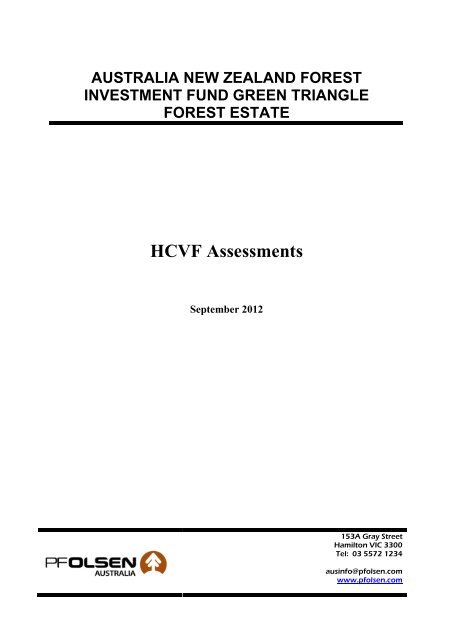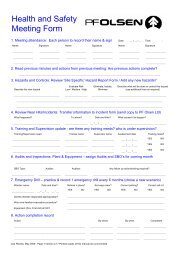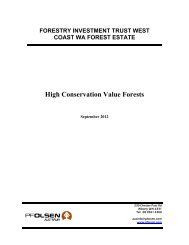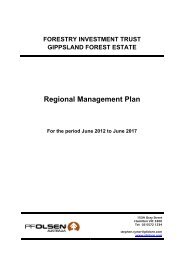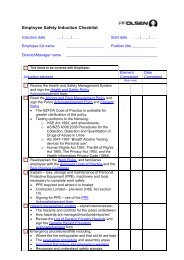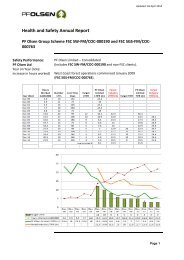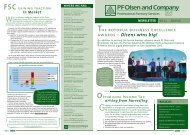HCVF Assessments - PF Olsen Limited
HCVF Assessments - PF Olsen Limited
HCVF Assessments - PF Olsen Limited
You also want an ePaper? Increase the reach of your titles
YUMPU automatically turns print PDFs into web optimized ePapers that Google loves.
AUSTRALIA NEW ZEALAND FOREST<br />
INVESTMENT FUND GREEN TRIANGLE<br />
FOREST ESTATE<br />
<strong>HCVF</strong> <strong>Assessments</strong><br />
September 2012<br />
153A Gray Street<br />
Hamilton VIC 3300<br />
Tel: 03 5572 1234<br />
ausinfo@pfolsen.com<br />
www.pfolsen.com
HIGH CONSERVATION VALUE ASSESSMENTS<br />
ANZFIF FOREST ESTATE<br />
Table of Contents<br />
Table of Contents ........................................................................................................................ 1<br />
Introduction ................................................................................................................................. 2<br />
Findings ....................................................................................................................................... 2<br />
Calvert HCV Assessment ............................................................................................................ 3<br />
Merna HCV Assessment ............................................................................................................. 8<br />
© <strong>PF</strong> <strong>Olsen</strong> (Aus) Pty Ltd<br />
All rights reserved.<br />
All rights of copying, publication, storage, transmission and<br />
retrieval in whole or part by any means and for all purposes<br />
except for bona fide copying by the entity that commissioned<br />
this report, as set out on the title page, are reserved.<br />
September 2012 Table of Contents Page 1
HIGH CONSERVATION VALUE ASSESSMENTS<br />
ANZFIF FOREST ESTATE<br />
Introduction<br />
Purpose<br />
This report summarises the results of Australian Ecological Research<br />
Services assessments of properties with potential High Conservation<br />
Value Forests owned by the Trust Company Pty Ltd as trustee for the<br />
Forest Investment Trust in the Green Triangle Region of Victoria.<br />
Findings<br />
HCV 1 HCV HCV HCV 4 HCV HCV<br />
1.1 1.2 1.3 1.4 2 3 4.1 4.2 4.3 5 6<br />
Calvert No No No No No Yes No No No No No<br />
Merna No No No No No No No No No No No<br />
PROPERTY<br />
Identified High<br />
Conservation<br />
Values<br />
Calvert<br />
PROPERTY<br />
HCV<br />
Regionally significant patch of<br />
Riparian Forest<br />
Future Steps<br />
Develop plans to maintain or enhance identified values in consultation<br />
with relevant stakeholders<br />
September 2012 Introduction Page 2
HIGH CONSERVATION VALUE ASSESSMENTS<br />
ANZFIF FOREST ESTATE<br />
Calvert HCV Assessment<br />
September 2012 Calvert HCV Assessment Page 3
Property Assessment for High Conservation Value<br />
Property: Calvert Date: 7 September 2012<br />
Address: Crescent Road, Simpson<br />
Assessment result: High Conservation Value (3.0)<br />
The conservation value of each Forest Management Unit (FMU) was assessed according to the High<br />
Conservation Value Forest Toolkit (Jennings et. al. 2003). A preliminary desktop study was undertaken<br />
using the EPBC Protected Matters Search Tool and the DSE Biodiversity Interactive Map to identify<br />
threatened flora and fauna species or their habitat that is known, likely or may occur within 5 km of the<br />
FMU. Potential cultural significance of properties was examined from heritage certificates and advice<br />
from the Victorian Aboriginal Heritage Register. Habitat hectare assessments were subsequently<br />
undertaken to assess the quality of any native vegetation that occurred within the FMU.<br />
The results of the assessment to determine whether the FMU is considered High Conservation Value are<br />
detailed in Table 1. A site inspection and habitat hectare assessment is yet to be undertaken at this site.<br />
Table 1. High Conservation Value Assessment.<br />
HCV 1: Forest areas containing globally, nationally and regionally significant concentrations<br />
of biodiversity values (e.g. endemism, endangered species, refugia).<br />
HCV 1.1 Protected areas Yes No<br />
Notes:<br />
This FMU is not within a protected area such as National Park, State Park or Conservation<br />
Reserve.<br />
HCV 1.2 Rare or threatened species Yes No<br />
Notes:<br />
Two threatened species or their habitat is known to occur within 5 km of property:<br />
Birds<br />
• Austalasian Bittern Botaurus poiciloptilus<br />
Plants<br />
• Tufted Club-sedge Isolepis wakefieldiana<br />
Four threatened species or their habitat likely to occur within 5 km of property:<br />
Fish<br />
• Dwarf Galaxias Galaxiella pusilla<br />
Mammals<br />
• Southern Brown Bandicoot (Eastern) Isoodon obesulus obesulus<br />
Plants<br />
• Clover Glycine Glycine latrobeana<br />
• Maroon Leek-orchid Prasophyllum frenchii
Three migratory species or their habitat likely to occur within 5 km of property:<br />
Migratory birds<br />
• White-bellied Sea-Eagle Haliaeetus leucogaster<br />
• Satin Flycatcher Myiagra cyanoleuca<br />
• Black-faced Monarch Monarcha melanopsis<br />
A further 14 threatened species and eight migratory species or their habitat may occur<br />
within 5 km of the property.<br />
This FMU is not considered High Conservation Value (1.2) according to the <strong>HCVF</strong> Toolkit as<br />
the FMU does not contain significant concentrations of rare or threatened species.<br />
HCV 1.3 Endemic species Yes No<br />
Notes:<br />
No endemic species are known to occur within the FMU.<br />
HCV 1.4 Critical temporal use Yes No<br />
Notes:<br />
The FMU does not provide habitat for maintaining significant temporal concentrations of<br />
species.<br />
HCV 2: Forest areas containing regionally significant large landscape level forests,<br />
contained within or containing the management unit, where viable populations of most if<br />
not all naturally occurring species exist in natural patterns of distribution and abundance.<br />
Notes:<br />
The FMU is not within a large forest area of native vegetation and fauna habitat.<br />
Yes<br />
No<br />
HCV 3: Forest areas that are in or contain rare, threatened or endangered ecosystems. Yes No<br />
Notes:<br />
Contains one vulnerable EVC:<br />
• Riparian Forest<br />
Contains one depleted EVC:<br />
• Lowland Forest<br />
Although the FMU contains only a small proportion of the Riparian Forest patch, this patch<br />
is the largest patch of Riparian Forest in the local area and is therefore considered High<br />
Conservation Value (3.0) according to the <strong>HCVF</strong> Toolkit. A site inspection will be required<br />
to verify the presence of Riparian Forest within the FMU.<br />
HCV 4: Forest areas that provide basic services of nature in critical situations<br />
(e.g. watershed protection, erosion control).<br />
HCV 4.1 Forests critical to water catchments Yes No<br />
Notes:<br />
The FMU does not play a critical role in protecting the catchment.<br />
HCV 4.2 Forests critical to erosion control Yes No<br />
Notes:<br />
Risk of erosion is negligible due to the relatively flat topography of the FMU.
HCV 4.3 Forests providing barriers to destructive fire Yes No<br />
Notes:<br />
The FMU does not contain forest types that provide barriers to destructive fires.<br />
HCV 5: Forests areas fundamental to meeting basic needs of local communities (e.g.<br />
subsistence, health, well-being).<br />
Notes:<br />
The FMU is not critical to the needs of local communities.<br />
HCV 6: Forest areas critical to local communities' traditional cultural identity (areas of<br />
cultural, ecological, economic or religious significance identified in cooperation with such<br />
local communities).<br />
Notes:<br />
There is no cultural association with the FMU.<br />
Yes<br />
Yes<br />
No<br />
No
Map Scale 1:55,000<br />
Page 1 of 1<br />
Calvert<br />
0 500 1000 1500 2000 m.<br />
Disclaimer: This map is a snapshot generated from Victorian Government data. This material may be of assistance to you but the State of Victoria does not guarantee that the publication is without flaw of any kind or is wholly appropriate for<br />
your particular purposes and therefore disclaims all liability for error, loss or damage which may arise from reliance upon it. All persons accessing this information should make appropriate enquiries to assess the currency of the data.<br />
Biodiversity Interactive Map A4 Landscape (c) The State of Victoria Department of Sustainability and Environment 2012<br />
Produced on Tue Sep 11 10:26:47 EST 2012
HIGH CONSERVATION VALUE ASSESSMENTS<br />
ANZFIF FOREST ESTATE<br />
Merna HCV Assessment<br />
September 2012 Merna HCV Assessment Page 8
Property Assessment for High Conservation Value<br />
Property: Merna Date: 7 September 2012<br />
Address: Crescent Road, Simpson<br />
Assessment result: Not considered High Conservation Value<br />
The conservation value of each Forest Management Unit (FMU) was assessed according to the High<br />
Conservation Value Forest Toolkit (Jennings et. al. 2003). A preliminary desktop study was undertaken<br />
using the EPBC Protected Matters Search Tool and the DSE Biodiversity Interactive Map to identify<br />
threatened flora and fauna species or their habitat that is known, likely or may occur within 5 km of the<br />
FMU. Potential cultural significance of properties was examined from heritage certificates and advice<br />
from the Victorian Aboriginal Heritage Register. Habitat hectare assessments were subsequently<br />
undertaken to assess the quality of any native vegetation that occurred within the FMU.<br />
The results of the assessment to determine whether the FMU is considered High Conservation Value are<br />
detailed in Table 1. A site inspection and habitat hectare assessment is yet to be undertaken at this site.<br />
Table 1. High Conservation Value Assessment.<br />
HCV 1: Forest areas containing globally, nationally and regionally significant concentrations<br />
of biodiversity values (e.g. endemism, endangered species, refugia).<br />
HCV 1.1 Protected areas Yes No<br />
Notes:<br />
This FMU is not within a protected area such as National Park, State Park or Conservation<br />
Reserve.<br />
HCV 1.2 Rare or threatened species Yes No<br />
Notes:<br />
Two threatened species or their habitat is known to occur within 5 km of property:<br />
Birds<br />
• Austalasian Bittern Botaurus poiciloptilus<br />
Plants<br />
• Tufted Club-sedge Isolepis wakefieldiana<br />
Four threatened species or their habitat likely to occur within 5 km of property:<br />
Fish<br />
• Dwarf Galaxias Galaxiella pusilla<br />
Mammals<br />
• Southern Brown Bandicoot (Eastern) Isoodon obesulus obesulus<br />
Plants<br />
• Clover Glycine Glycine latrobeana<br />
• Maroon Leek-orchid Prasophyllum frenchii
Three migratory species or their habitat likely to occur within 5 km of property:<br />
Migratory birds<br />
• White-bellied Sea-Eagle Haliaeetus leucogaster<br />
• Satin Flycatcher Myiagra cyanoleuca<br />
• Black-faced Monarch Monarcha melanopsis<br />
A further 14 threatened species and eight migratory species or their habitat may occur<br />
within 5 km of the property.<br />
This FMU is not considered High Conservation Value (1.2) according to the <strong>HCVF</strong> Toolkit as<br />
the FMU does not contain significant concentrations of rare or threatened species.<br />
HCV 1.3 Endemic species Yes No<br />
Notes:<br />
No endemic species are known to occur within the FMU.<br />
HCV 1.4 Critical temporal use Yes No<br />
Notes:<br />
The FMU does not provide habitat for maintaining significant temporal concentrations of<br />
species.<br />
HCV 2: Forest areas containing regionally significant large landscape level forests,<br />
contained within or containing the management unit, where viable populations of most if<br />
not all naturally occurring species exist in natural patterns of distribution and abundance.<br />
Notes:<br />
The FMU is not within a large forest area of native vegetation and fauna habitat.<br />
Yes<br />
No<br />
HCV 3: Forest areas that are in or contain rare, threatened or endangered ecosystems. Yes No<br />
Notes:<br />
Contains one vulnerable EVC:<br />
• Herb-rich Foothill Forest<br />
Contains one depleted EVC:<br />
• Lowland Forest<br />
Although the FMU contains a threatened EVC it is not considered High Conservation Value<br />
(3.0) according to the <strong>HCVF</strong> Toolkit as the EVC is a relatively small patch and several larger<br />
patches exist locally.<br />
HCV 4: Forest areas that provide basic services of nature in critical situations<br />
(e.g. watershed protection, erosion control).<br />
HCV 4.1 Forests critical to water catchments Yes No<br />
Notes:<br />
The FMU does not play a critical role in protecting the catchment.<br />
HCV 4.2 Forests critical to erosion control Yes No<br />
Notes:<br />
Risk of erosion is negligible due to the relatively flat topography of the FMU.
HCV 4.3 Forests providing barriers to destructive fire Yes No<br />
Notes:<br />
The FMU does not contain forest types that provide barriers to destructive fires.<br />
HCV 5: Forests areas fundamental to meeting basic needs of local communities (e.g.<br />
subsistence, health, well-being).<br />
Notes:<br />
The FMU is not critical to the needs of local communities.<br />
HCV 6: Forest areas critical to local communities' traditional cultural identity (areas of<br />
cultural, ecological, economic or religious significance identified in cooperation with such<br />
local communities).<br />
Notes:<br />
There is no cultural association with the FMU.<br />
Yes<br />
Yes<br />
No<br />
No
Merna<br />
0 500 1000 1500 2000 m.<br />
Disclaimer: This map is a snapshot generated from Victorian Government data. This material may be of assistance to you but the State of Victoria does not guarantee that the publication is without flaw of any kind or is wholly appropriate for<br />
your particular purposes and therefore disclaims all liability for error, loss or damage which may arise from reliance upon it. All persons accessing this information should make appropriate enquiries to assess the currency of the data.<br />
Biodiversity Interactive Map A4 Landscape (c) The State of Victoria Department of Sustainability and Environment 2012<br />
Map Scale 1:55,000<br />
Produced on Tue Sep 11 10:25:23 EST 2012<br />
Page 1 of 1


